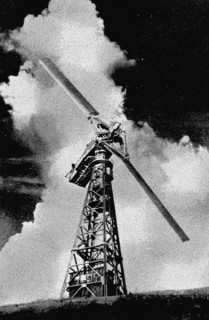
I saw this headline, and couldn’t help myself.
(Real article: Narwhals Are Helping NASA Understand Melting Ice and Rising Seas – Bloomberg, via mylesb.)
work as if you live in the early days of a better nation

I saw this headline, and couldn’t help myself.
(Real article: Narwhals Are Helping NASA Understand Melting Ice and Rising Seas – Bloomberg, via mylesb.)
(video from Apollo 11 Saturn V Launch (HD) Camera E-8)
 This is how wind turbines were supposed to look, at least in the 1940s. It’s the experimental Smith-Putnam 1.25 MW unit than ran for a short while on a hill near Rutland, VT. The picture’s from a rather falling-apart copy of Large Horizontal-axis Wind Turbines (Thresher, R. W., & Solar Energy Research Institute. (1982). Large horizontal-axis wind turbines: Proceedings of a workshop held in Cleveland, Ohio, July 28-30, 1981. Golden, Colo: Solar Energy Research Institute) that I rescued from Jim‘s recycling years ago.
This is how wind turbines were supposed to look, at least in the 1940s. It’s the experimental Smith-Putnam 1.25 MW unit than ran for a short while on a hill near Rutland, VT. The picture’s from a rather falling-apart copy of Large Horizontal-axis Wind Turbines (Thresher, R. W., & Solar Energy Research Institute. (1982). Large horizontal-axis wind turbines: Proceedings of a workshop held in Cleveland, Ohio, July 28-30, 1981. Golden, Colo: Solar Energy Research Institute) that I rescued from Jim‘s recycling years ago.
The first part of these proceedings has a historical review of the Smith-Putnam turbine, including an excerpt from the S. Morgan Smith Company’s house organ on the project. As the rest of the book is pretty much all about the MOD series of turbines, it’s of less interest. I’ve scanned the bits about the Smith-Putnam turbine, and put them here: NASA_DOE-1981-large_horizontal_axis_wind_turbines-excerpt. If anyone wants the book, let me know. It’s very ratty, but readable.
I’ve written about this turbine before, but in relation to a packet of crayons. More awesome turbine pictures from Paul Gipe: Smith-Putnam Industrial Photos.
So it was 36 years ago today that we put a couple of folks on our satellite. Big deal. People have been saying that it was the greatest achievement basically ever, and yet I remain strangely unmoved.
You have to wonder about the huge amount of energy expended in a moon launch compared to the positive benefit it brings. It might have allowed a couple of military types to prance about in low gravity, but really, what have the moon landings done for us?
Someone’s going to say computers. Well, if we’d have stopped at 1974-level electronics, maybe so. But I remember computers in 1974 — and they were huge, and not very impressive.
Someone else will probably say high-tech materials. While things like aramid fibres are technically neato-mosquito, like many technologies designed around the space program, they’re basically single-use. It’s no surprise then that the Challenger enquiry folks had difficulty with Miner’s law when they’d previously only used things once.
Someone had better not say foods. Tang is not a food group, merely a useful additive for gin.
I know I’ll never make it to space. I have no interest in messing up our environment here, just to get somewhere colder and less hospitable. I think I’m expected to be a space-nut, since I was born just before the moon landing, grew up with SkyLab and such, and became an engineer. But if it’s that much trouble to travel so short a distance in space, what chance have we in the stars?
NASA SP7010, aka Clarity in Technical Reporting by Dr. Samuel Katzoff, manages to say more about technical writing in 30 pages than most books ten times the size. There’s not a single illustration or bullet point, yet it’s lucid and precise.
It seems that Dr Katzoff took special care to ensure that young engineers at NASA knew how to communicate. As chief scientist at the NASA Langley Research Center, he certainly knew the importance of good technical reporting.
NB: I had assumed that Dr Katzoff, from various sources on the internet, had passed on. I’m told (see below) he’s alive and well. If he didn’t say something in Clarity in Technical Reporting about checking sources, well …
Best wishes to Dr K., anyway!